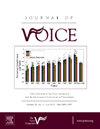金属乐歌手发音障碍的普遍性及声乐教育的影响:主观分析。
IF 2.5
4区 医学
Q1 AUDIOLOGY & SPEECH-LANGUAGE PATHOLOGY
引用次数: 0
摘要
平均而言,歌唱者主观上出现发音障碍的比例要高于普通人。在使用极端发声技巧时,声门上的结构会起到保护声带的作用。大多数金属歌手都是自学这种特殊的演唱风格。声乐训练可以对嗓音产生积极影响,预防嗓音问题。研究的目的是了解金属乐歌手发音障碍的发生率,以及这对专业或声乐教育的影响。受试者必须填写一份在线问卷,其中包括两份关于说话和唱歌嗓音的经过验证的标准化问卷:嗓音障碍指数简版(VHI 12)和歌唱嗓音障碍指数(SVHI)。金属歌手发音障碍的发病率为 12.2%。74 名参与者中有 9 人的 (S)VHI 分数有所提高。其中 6 人是自学唱歌。全职歌手或学习唱歌的歌手均未发现发音障碍。教育或职业与发音障碍之间的相关性在统计学上并不显著。学习或参加歌唱课程的女性多于男性。这一差异在统计学上有显著意义。在我们的研究中,12.2% 的患病率相当低,与我们的假设相反。我们可以认为,针对金属唱法的声乐教育是有用的,但不是必须的,而且通过金属唱法导致发音障碍的人数很少。健康的发声技巧并不一定是声乐课程的结果。本文章由计算机程序翻译,如有差异,请以英文原文为准。
Prevalence of Dysphonia in Metal Singers and the Impact of Vocal Education: A Subjective Analysis
On average, the prevalence of subjectively indicated dysphonia in singers is higher than in the general population. When using extreme vocal techniques supraglottic structures are involved to protect the vocal folds. Most of the metal singers learn this specific singing style autodidactically. Vocal training can have a positive effect on the voice and prevent voice problems. The aim of the study was to find out the prevalence of dysphonia in metal singers and the impact this has on the profession or the vocal education.
The subjects had to fill out an online questionnaire including two validated and standardized questionnaires about the speaking and singing voice: The short version of the Voice Handicap Index (VHI 12) and the Singing Voice Handicap Index (SVHI).
The prevalence of dysphonia in metal singers is 12.2%. 9 out of 74 participants showed an increased (S)VHI score. 6 of these participants learned singing autodidactically. No dysphonia was found in any singer who sings full-time or studied singing. The correlation between education or profession and dysphonia was statistically not significant. More women than men studied or took singing lessons. This difference was statistically significant.
The prevalence of 12.2% in our study is quite low and contrary to our assumption. We can assume, that a vocal education for the metal singing style is useful but not mandatory and the number of persons with dysphonia through metal singing is low. A healthy vocal technique does not necessarily have to be the result of voice lessons.
求助全文
通过发布文献求助,成功后即可免费获取论文全文。
去求助
来源期刊

Journal of Voice
医学-耳鼻喉科学
CiteScore
4.00
自引率
13.60%
发文量
395
审稿时长
59 days
期刊介绍:
The Journal of Voice is widely regarded as the world''s premiere journal for voice medicine and research. This peer-reviewed publication is listed in Index Medicus and is indexed by the Institute for Scientific Information. The journal contains articles written by experts throughout the world on all topics in voice sciences, voice medicine and surgery, and speech-language pathologists'' management of voice-related problems. The journal includes clinical articles, clinical research, and laboratory research. Members of the Foundation receive the journal as a benefit of membership.
 求助内容:
求助内容: 应助结果提醒方式:
应助结果提醒方式:


